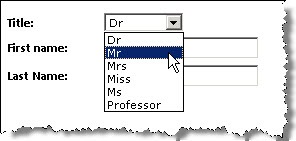SPDataSource - a refresher
So last time in part 1 of this 2-part series, we saw how SPDataSource is a great option for fetching data from lists since not only does it do the actual work of fetching the items for you, it also does this without any C#/VB.Net code. We can retrieve all the items from the list, or optionally supply a CAML query along with the list details if we wish to filter/sort the items. So as I showed in part 1, we can easily display a dropdown containing the items from a list with the following markup:
<SPWebControls:SPDataSource runat="server" ID="dsPersonTitles" DataSourceMode="List"
SelectCommand="<Query><OrderBy><FieldRef Name='SortOrder' Ascending='true' /></OrderBy></Query>"
<SelectParameters>
<asp:Parameter Name="WebUrl" DefaultValue="/configuration/" />
<asp:Parameter Name="ListName" DefaultValue="PersonTitles" />
</SelectParameters>
</SPWebControls:SPDataSource>
<asp:DropDownList runat="server" ID="ddlPersonTitles" CssClass="title" DataSourceID="dsPersonTitles" DataTextField="Title" DataValueField="ID">
</asp:DropDownList>
We also saw how SPDataSource offers more than just retrieving items from a list, with the following other 'modes' (see part 1 for more details on these):
- CrossList - similar to doing a query with SPSiteDataQuery across all lists in a site collection
- ListItem - show field values from a single list item
- Webs - lists all webs in a site collection
- ListOfLists - lists all lists in a web
What I want to focus on this time is how to use parameters with SPDataSource, since when using the control for real you'll often want to do this.
Parameters with SPDataSource
SPDataSource works like other .Net data source controls, so the key to passing parameters is using one of the .Net 2.0 parameter classes, either declaratively (in markup) or in code. The example above shows using the basic Parameter class by setting the DefaultValue property to a known string, but the following parameter types can also be used (though note I haven't tried them all and the SPD Team Blog article I mentioned says somewhat vaguely that "most" of them can be used!):
- ControlParameter
- CookieParameter
- FormParameter
- ProfileParameter
- QueryStringParameter
- SessionParameter
Effectively using one of these saves you writing code to read the value from the respective location and passing it to SPDataSource yourself. I think that ControlParameter and QueryStringParameter are possibly of the most value, though all could be interesting depending on your requirements. As an example, to get the value a user selected earlier from a dropdown containing a list of lists and pass it to a SPDataSource control I would need:
<SelectParameters>
<asp:Parameter Name="WebUrl" DefaultValue="/configuration/" />
<asp:ControlParameter Name="ListName" ControlID="ddlLists"
PropertyName="SelectedValue"/>
</SelectParameters>
I seemed to have some control execution lifecycle fun with ControlParameter but it did work in the end. To pull the value from a 'userID' querystring parameter I would need:
<SelectParameters>
<asp:QueryStringParameter Name="userId" QueryStringField="userId" />
</SelectParameters>
And that's not all - I can also drop a parameter value into a string such as a CAML query used in the earlier example of 'List' mode:
<SPWebControls:SPDataSource runat="server" ID="dsPersonTitles" DataSourceMode="List"
SelectCommand="<Query><OrderBy><FieldRef Name='{SortField}' Ascending='{SortAsc}' /></OrderBy></Query>">
<SelectParameters>
<asp:Parameter Name="WebUrl" DefaultValue="/configuration/" />
<asp:Parameter Name="ListName" DefaultValue="PersonTitles" />
<asp:QueryStringParameter Name="SortField" QueryStringField="SortField" DefaultValue="SortOrder" />
<asp:QueryStringParameter Name="SortAsc" QueryStringField="SortAsc" DefaultValue="true" />
</SelectParameters>
</SPWebControls:SPDataSource>
Notice here I'm dynamically specifying the sort field and direction from querystring parameters. Cool stuff.
Even cooler is the idea of building your own parameter control - one that strikes me is one for retrieving values from a user's SharePoint profile (since the ProfileParameter listed above refers to ASP.Net profiles). Scott Mitchell has a great guide to this at Accessing and Updating Data in ASP.NET 2.0: Creating Custom Parameter Controls.
Summary
So we've covered a lot of ground there, so here's a recap of why the SPDataSource is your friend:
- Can bind to any control which can do data-binding - DropdownList, ListBox, CheckBoxList are some obvious candidates, but consider also Repeater, DataGrid and SharePoint DataView/SPGridView controls
- Can easily get parameters from other controls, querystring, session, form values etc. (or write some code to fetch from another location)
- Can use a variety of modes to make different queries e.g. items in a list, properties of a list item, webs in a site etc.
If you want to see more I recommend reading SPDataSource and Rollups with the Data View - this emphasises using SPDataSource with SharePoint DataViews but also has some good examples I haven't covered, such as using the 'CrossList' mode.


